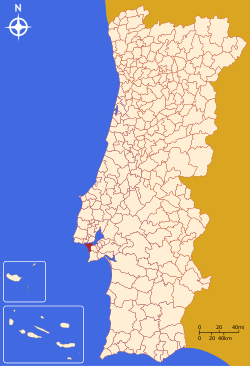Almada
| Almada | |||
|---|---|---|---|
| Municipality | |||

Aerial view of Almada with the famous Sanctuary of Christ the King
|
|||
|
|||
 |
|||
| Coordinates: 38°40′49″N 9°9′30″W / 38.68028°N 9.15833°WCoordinates: 38°40′49″N 9°9′30″W / 38.68028°N 9.15833°W | |||
| Country |
|
||
| Region | Lisbon | ||
| Subregion | Península de Setúbal | ||
| Metropolitan area | Lisbon | ||
| District | Setúbal | ||
| Parishes | 5 | ||
| Government | |||
| • President | Joaquim Estêvão Miguel Judas (CDU) | ||
| Area | |||
| • Total | 70.21 km2 (27.11 sq mi) | ||
| Elevation | 33 m (108 ft) | ||
| Lowest elevation | 0 m (0 ft) | ||
| Population (2011) | |||
| • Total | 174,030 | ||
| • Density | 2,500/km2 (6,400/sq mi) | ||
| Time zone | WET/WEST (UTC+0/+1) | ||
| Postal code | 2805 | ||
| Area code | 21 | ||
| Patron | São João Baptista | ||
| Website | http://www.m-almada.pt | ||
Almada (Portuguese pronunciation: [aɫˈmaðɐ]) is a city and a municipality in Portugal, located on the southern margin of the Tagus River, on the opposite side of the river from Lisbon. The two cities are connected by the 25 de Abril Bridge. The population in 2011 was 174,030, in an area of 70.21 km². The urbanized center had a population of 101,500 in 2001.
Human presence in the area of Almada dates to the end of the Neolithic period about 5000 years ago; archeological excavations performed in the municipality suggest that non-sedentary nomadic tribes may have occupied this location sporadically. The gradual development of settlement here made its greatest advance with the coming of Islamic civilization, when Muslims constructed a fort at Almada to defend and monitor the entrance to the Tagus River. Lying across the river from Lisbon, the area of Almada was a crossroads for a succession of various peoples who traded along the Tagus, including Phoenicians, Romans and Moors.
As one of the principal Arab military bases along the southern margin of the Tagus, Almada was conquered by the Christian forces of Afonso I with the aid of English Crusaders in 1147. Alongside these Christians there lived many free Moors and Jews, under the royal protection guaranteed them by Afonso I in the charter of 1170 (which applied to all the former Moorish strongholds at Lisbon, Almada, Palmela and Alcácer).
Almada received a foral from King Sancho I in 1190, although it came at a price: Miramolim Jacub-Abu-Jassuf, son of the Moorish leader who had laid siege to Santarém in 1171, was angered by the Christian victories and gathered a large army. He boldly attacked in the north, conquering Alcácer do Sal and Silves, while forcing the residents of Almada, Palmela and other towns along the Tagus into hiding. It would be some time after the death of Sancho before this region would be restored to Portuguese control.
...
Wikipedia


